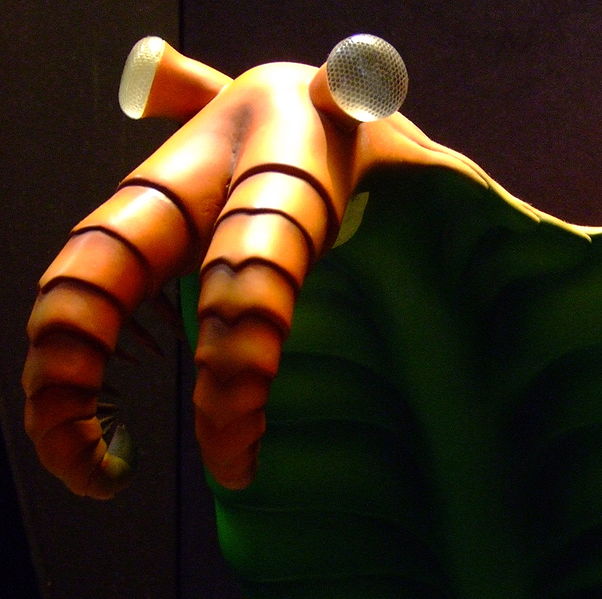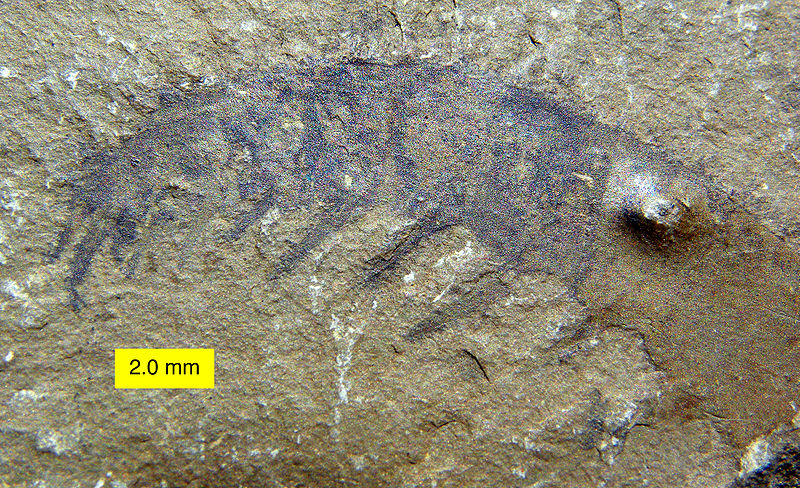
Part praying mantis, part flatworm, part geminating snuffleupagus: Model of Anomalocaris from the Natural History Museum, London. Creative Commons Gaetan Lee.
On the list of hallucinatory animals, the Cambrian creation known as Anomalocaris has held a particular grasp on natural history buffs’ imagination. Its name (essentially “weirdo shrimp”), its fascinating path to discovery, and its use as a Cambrian fall guy in Burgess Shale recreations have all contributed to this. Natural history documentaries, in particular, have tended to portray this thing patrolling the Cambrian oceans and harassing helpless trilobites with the cool assurance of a Great White Shark. In my copy of “Prehistoric Life: The Definitive Visual History of Life on Earth” published by DK just last year (and highly recommended), the caption of the beautiful full-color page describing Anomalocaris declares “3 ft 3 in The length of the largest Anolmalocaris specimens. Its size and formidable mouthparts made it a top predator of the Cambrian seas.”
Before I come to the current study, it’s worth knowing something about the history of this thing. In the world of Cambrian paleontology, Anomalocaris is a superstar. Life’s first big multicellular experiment (that we know about) — the Ediacaran — was mostly about soft-bodied life. Its second great multicellular experiment is the one that gave rise to most of the major groups we recognize today. This was the community of organisms famously discovered in the Canadian Burgess Shale, and it is the one in which Anomalocaris was found. The only problem was that when scientists first found it, they thought they had three separate living things — a real life enactment of the story of the blind men and the elephant.
First found was a shrimp’s tail — but only the tail. It was this that was named Anomalocaris.

A proboscis of Anomalocaris. On first glance, they thought it was a weird shrimp because its little "appendages" were not jointed, unlike modern shrimp. As it turns out, it was a weirdo shrimp because it wasn't a shrimp.
Next found was a pineapple ring — or what looked like a pineapple ring. Captain Morgan notwithstanding, scientists interpreted this as a squashed jellyfish and named it Peytoia. Finally, scientists found a fossil they judged to be a sponge, and named it Laggania. The pineapple ring was attached, but was interpreted as a jelly fish that had just happened to settle on top of the sponge and got squashed into place. Finally, the scientist Harry Whittington at last found a fossil in which the shrimp hinder was attached to the pineapple ring. No, really? What the heck was this thing? A few years later, they put it all together: the sponge was the body, the pineapple ring the mouth, and the cocktail shrimp was one of a pair of probosci of this titanically large (for the Cambrian) animal. Anomalocaris, they called it, since earliest taxonomic names have precedence, and judged it to be the terror of the Burgess Shale fauna.
For the Cambrian, this thing was big. At about one meter (three feet) it dwarfed the other species we typically find in the ecosystem. But it turns out that titanism may have been the size enhancement that comes with being a whale shark, not a white shark. Scientists at the Denver Museum of Nature and Science conducted computer studies of Anomalocaris‘s bizarre mouthparts and found that it was extremely unlikely it was capable of crushing much more than a gummy bear, much less an armor-plated trilobite. Supporting their study, they examined some 400 fossil Anomalocaris mouthparts — and found nary a chip or scratch. Considering how soft our fingernails are and how frequently they get chipped or scratched, I’m afraid it appears Anomalocaris must have been chowing down on something either very soft or tiny indeed. Soft worms, they suggest — or plankton.
So the vicious predator may have been a gentle, harmless (unless you happen to be a plankter) filter feeder. At least — that’s the tale now! With as many twists and turns as this story has taken, I wouldn’t be surprised if another surprise lies in wait. For instance . . . scientists have actually found and identified fecal pellets of this thing. That’s one study I, for one, will be glad not to have to do . . .


{ 3 trackbacks }
{ 0 comments… add one now }